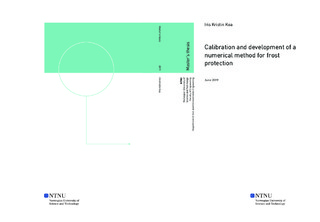| dc.description.abstract | Frost heave and spring thaw can be critical contributors to pavement deterioration in seasonal frost regions. Several numerical programs are available to predict frost penetration depth, but the lack of fixed material parameters often leads to unreliable estimates and hence inaccurate frost design. To prevent detrimental frost heave and spring thaw conditions in the foundation layers, adapting numerical models to site-specific conditions is essential. This study uses the module Heat transfer in porous media in COMSOL Multiphysics to model heat flux in seven full-scale road sections with different frost protective layers. Numerical models are built for each section, using actual ambient air temperature as the top boundary condition, and material properties are adjusted to fit temperature profiles measured over seven weeks. The models fit field data with an average accuracy of 0.56 °C. The final thermal properties for each material in the road structure are presented for use in further calibration. It is assumed that applying continuous surface measurements as the top boundary condition would be a key improvement for future work. A further recommendation is to increase the modeling period, preferably to a whole year consisting of a cold winter. | |
